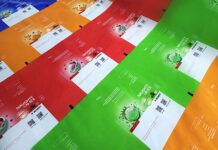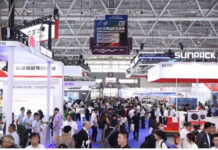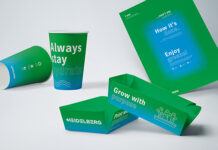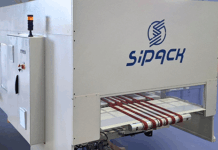“Flexo Innovation and Sustainability” is the title of the symposium organized last September 26th at the headquarters of Carminati, a prepress service in Antegnate (Bg) in collaboration with XSYS which recently supplied Carminati with the second complete ThermoflexX Catena WDLS line for the automated and sustainable production of flexo plates and other prestigious partners
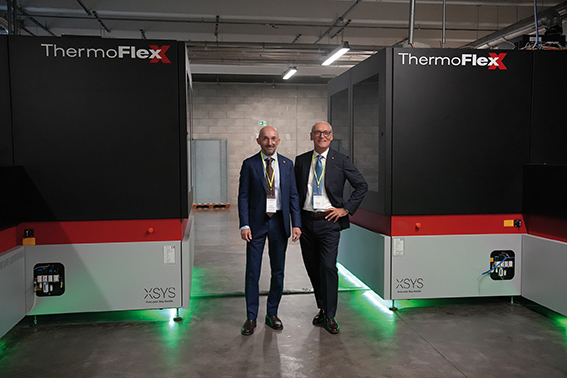
Perhaps Carlo Carminati had not even imagined a day like this, partly because of his shy and reserved nature, partly also because the succession of work leaves little space for companies to organize conferences, this was in fact the first open house dedicated by the service in Antegnate (Bg) to its customers. The premises for a successful day were all there, given that Carminati has been investing in innovative technologies for some years, combined with strong internal Research and Development that have led it to climb to the top step of the podium of a competition like BestInFlexo 2024.
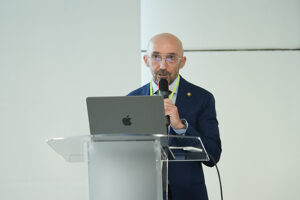
The partnership with Xsys Italia, in particular with Roberto Malagù, Sales Manager Italy and his staff, had already given excellent results that materialized in 2022 with the installation of the first ThermoflexX Catena WDLS in Italy, a sustainable and fully automated technological solution. Carminati recently installed the second complete ThermoflexX Catena WDLS line and is currently the only service in the world that can boast this double configuration. “An event like this couldn’t go unnoticed, and so in agreement with Roberto Malagù of Xsys Italia we decided to organize a technical conference inviting brand owners, technology suppliers and our boxmaking customers to discuss together the technological developments and the main trends in the sector, also giving them the opportunity to visit our company”, Carlo Carminati tells us with satisfaction.
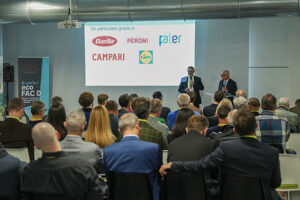
“I would like to thank Carlo Carminati for confirming his trust in Xsys and in our technologies and materials. It is incredible to see how many people have responded positively to his and our invitation (over 100 people – editor’s note) and we will continue to invest in research and development to support companies like Carminati with which reasoning in terms of partnership is certainly the key to develop successful solutions and products”, said Lars Kraeft CCO, MD of Xsys Global.
Barilla’s vision for a sustainable packaging
Andrea Bordini, Global Packaging Innovation & CoE Graphics Director of Barilla, provided the group’s vision in the field of packaging sustainability. Let’s start from the assumption that 100% of the packaging used by Barilla in Italy is designed to be recyclable. This is the result of a journey that has lasted years and is only possible by following some mandatory principles, focusing on the reduction of material consumption, working on technical specifications, the use of materials from renewable sources that do not compete with the food chain and the promotion of recycling.
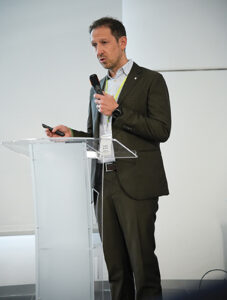
“You will have noticed that to reduce materials, Barilla has eliminated plastic windows from pasta boxes, and this marries the philosophy of reducing unnecessary and fossil-based components, so as to facilitate recovery and recycling at the end of their life”, says Andrea Bordini.
Barilla’s commitment is also aimed at stimulating the packaging supply chain towards increasing the percentage of recycled materials to produce new packaging. This Barilla policy has led to 58% recycled material in paper packaging today, as much as 89% in corrugated cardboard, and 15% in glass, percentage that Barilla is constantly increasing.
“We are working with paper mills to try to arrive at a clean recycled cardboard that can have mechanical properties adequate to our requests, without compromising the functionality of the packaging. Furthermore, where the product to be packaged allows it, we are considering reducing the use of materials from non-renewable sources, thus providing answers to people’s concerns in terms of sustainability. We are carefully following GS1’s proposal to switch to 2D codes starting in 2028 and therefore to remove 1D codes; we are interested in evaluating the application also in this transitional period until 2028 in order to understand and make the most of the potential of this new codification”.
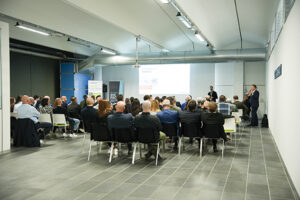
For Barilla it is clear that each type of packaging adopted will be developed following people’s feedback, an activity that is then followed with meticulous care by the inserting of new products on the shelf, which denotes the brand’s great attention to consumers.
“Since I have an audience of flexo printers in front of me, I can happily confirm that for Barilla flexo technology certainly has important potential for the future; we are already switching some products to this technology and where possible in the future we will also evaluate switching some primary packaging lines from gravure to flexo, which in recent years has filled the qualitative gap that was more evident in the past. Quality is fundamental precisely for the presentation of our products on the shelf and the pack is the first point of contact with which Barilla tells people about the attention to detail that we put into our products”, concludes Andrea Bordini.
Carminati and the development from flat top dot to microcells
Carminati company was founded in 1960 with the name Carminati & Guizzardi and was one of the very first companies to introduce and spread the use of hand-engraved rubber clichés. Since then, even without appearing too much, the Bergamo service, which has been permanently based in Antegnate since 2013, has grown steadily, following the technological evolution of the market, becoming a leading player.

“The first flat top dot photopolymer plate was patented in 2010 by an American service and the following year we patented it in Europe, with a different process compared to our American colleagues, a system still in use today in our production”, says Carlo Carminati. The next stage of this evolution was in 2020 when Carminati introduced LED light to image photopolymer plates, which is considered the technology of the future in pre-press and in which all the players in the sector are dedicating significant investments.
The digital plate reproduces writings but also screens, through which photographic images are reproduced in print. Screens are composed of dots and those produced by traditional plates have a pointed shape with perpendicular shoulders, generally unstable, which for example on corrugated cardboard reproduces images with the famous “wash-boarding” effect, that is, the corrugated cardboard flutes are visible, an effect also due to the imperfect flatness of a complicated support such as corrugated cardboard.
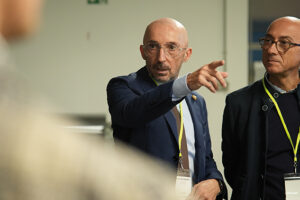
“Our patented OL Dot system, through the use of a very powerful light, creates a surface crystallization of the plate, isolating it from external oxygen and giving life to the famous flat top dot in some minutes. The heart of our patent is composed of an imager that we designed and built internally with halogen lamps”, says Carminati. The advantages of this system were an excellent quality for the time but unfortunately the downside was the high cost of these lamps, which required a weekly change for a cost of €1500 per week, with very high energy consumption and plate exposure times of 40 minutes.
Fortunately, today the situation has changed, and technological development helped Carminati with the development of OLed lamps, which guarantee a total power of 10 thousand Watts against the 12 thousands of halogen, and an installed exposure power of 5100 mW/cm2 against the 300 of the previous technology. The plate imaging time has also been improved to 15 minutes against 40 and consumption per plate has now dropped to 2.67 kWh against 8.
The two OLed imagers patented by Carminati respond perfectly to the needs of a more sustainable production from all points of view, from the environmental to the economic one.
OLed technology has also brought a great improvement in quality, today microcells are applied to the surface of polymer plates, Carminati’s commitment has been and will be to find the best performing ones for printing on corrugated cardboard.
All this translates into better ink extraction from the anilox and therefore a general improvement in transfer to the support, with a consequent better discharge and therefore better cleaning of the cliché. Start-ups are much faster but also stability in production has significantly improved.
“With these new developments, the need to equip ourselves with an extremely effective but equally delicate washing system has finally emerged, which we have found in the new Catena WDLS”, concludes Carminati.
Blue is the new green
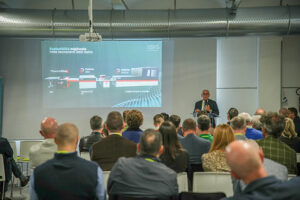
With these words game, Roberto Malagù presented Xsys’ unique and innovative approach towards a more sustainable future, also in light of market trends that see consumers putting a more attentive and aware lifestyle at the center of their choices, including the consequences that each of our actions entail, and which then influence purchasing choices. Companies must therefore understand consumer choices and adapt their market strategies to remain competitive.
How can Xsys contribute to all this?
“Xsys has products and technologies capable of accompanying the flexo printing market towards more sustainable production and at Drupa 2024 we presented our latest innovation, the Nyloflex ECO series of plates which are part of our contribution to greater environmental sustainability in the world of flexo printing, thanks to resource-efficient production, reflecting our eco-sustainable mentality which includes the use of renewable sources whenever possible”.
We are talking about the nyloflex ECO Series plates, perfect for printing on paper and cardboard (ECO ACT D) and post print always for corrugated cardboard (ECO FAC D). These plates are composed of 20 to 29% renewable and bio-based raw material, allow significant energy savings thanks to 20% faster processing, are consistent and reliable in printing, helping to reduce waste and are suitable for imaging with both tubes and LEDs.
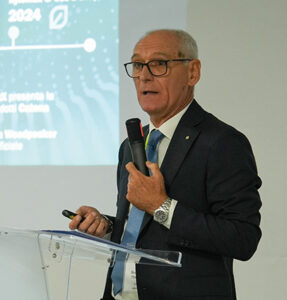
“The ECO FAC D plate is the result of collaboration and tests carried out with selected partners around the world and Carminati, unique in Italy, is among them. I would therefore like to thank Carlo and his collaborators because it is thanks to these companies always attentive to innovations, to the constant search for quality and innovations to transfer to the market and their customers, that we manufacturers are able to put our projects into practice”, says Malagù.
Xsys, also using artificial intelligence, has developed intelligent software solutions to reduce waste. This is EcoFiIIX, a function of the MultiPlate software that allows you to apply surface structures in the non-printable areas of the plate, reducing the accumulation of solid content in the washing solvent and minimizing the need to frequently replenish fresh solvent, up to -30%.
“As for technologies, which are the focus of this open house with Carminati, our proposal is Catena WDLS, a fully automatic line to produce plates that includes washing, oven, finishing, stacker and final exit. The line is completely closed, and the operator never comes into contact with the solvent. An interesting feature is the intelligent heating system of the ovens that contributes to save energy consumption. This is the final part of our solution, it can easily work alone, but if connected to our ThermoFlexX 80 imager for LAM ablation on the plates and the ThermoflexX Catena E80 LED imager, it can become a fully automated plate production chain called ThermoflexX Catena Plus for maximum efficiency”, concludes Roberto Malagù.
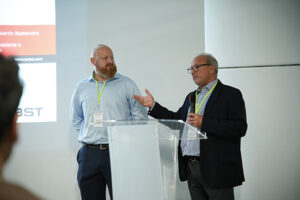
BOBST, SIMEC, CARMINATI together for excellence in corrugated cardboard printing
With Dominique Ventura and Guillaume Martin-Bastenaire of BOBST we entered the press room with the presentation of the innovations introduced by the group, in particular the new Masterflex HD+, a concentration of technology and innovation, with a new design that from now on will distinguish all BOBST machines, as regards printing on corrugated cardboard, presenting a successful case history: the Swiss manufacturer printed a sample job with the new Masterflex HD+, using the plates supplied by Carminati.
 Simec also participated in this project, presented during the latest edition of the FEFCO Congress, which provided its innovative Caboll anilox cylinders for the occasion, which were then expl
Simec also participated in this project, presented during the latest edition of the FEFCO Congress, which provided its innovative Caboll anilox cylinders for the occasion, which were then expl
The day of talks was closed by Marco Capoferri, Sei Laser, who presented the latest innovation for the laser production of corrugated cardboard packaging and displays, a new sector for Sei Laser, already present in other sectors of label converting, flexible packaging and graphic arts.
Great satisfaction in the room for the over 100 operators present who responded to the invitation of Carminati and Xsys for a day that represented another important stage in the virtuous and successful path undertaken by Carminati and all its partners.






